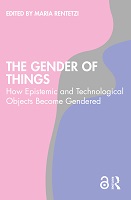Chapter Introduction
Gendering Things
| dc.contributor.author | Rentetzi , Maria | |
| dc.date.accessioned | 2023-11-09T11:01:12Z | |
| dc.date.available | 2023-11-09T11:01:12Z | |
| dc.date.issued | 2024 | |
| dc.identifier.uri | https://library.oapen.org/handle/20.500.12657/79421 | |
| dc.description.abstract | Nature was called on to justify what was based on social stereotypes and gender preconceptions ever since the Cold War. Gender discrimination in the US space programme indeed has a long history. Imaging phantoms simulating the human body or parts of it played that exact role. Right after the Second World War, the International Commission on Radiation Protection recognized the need to formulate a set of standard biological parameters, describing the “average individual,” that could be used to calculate permissible radiation doses for those working with radionuclides. Designing artefacts such as spacesuits based on the universal and the standard, reinforces the importance of physicality and justifies exclusion. It prescribes femininity as much as it does masculinity, both in the singular. For long, the history of technology has focused on artefacts as technical entities and scrutinized the role of inventors, engineers, scientists, corporations, the state, regulators, the press, and of course users and consumers. | en_US |
| dc.language | English | en_US |
| dc.subject.other | Gender studies; feminist new materialism; gendered objects; history of science;material culture; technoscience | en_US |
| dc.title | Chapter Introduction | en_US |
| dc.title.alternative | Gendering Things | en_US |
| dc.type | chapter | |
| oapen.identifier.doi | 10.4324/ 9781003379225- 1 | en_US |
| oapen.relation.isPublishedBy | 7b3c7b10-5b1e-40b3-860e-c6dd5197f0bb | en_US |
| oapen.relation.isPartOfBook | e403d4fd-e5d0-469a-9d03-577f44c2a809 | en_US |
| oapen.relation.isbn | 9781032459097 | en_US |
| oapen.relation.isbn | 9781032459127 | en_US |
| oapen.imprint | Routledge | en_US |
| oapen.pages | 21 | en_US |
| peerreview.anonymity | Single-anonymised | |
| peerreview.id | bc80075c-96cc-4740-a9f3-a234bc2598f1 | |
| peerreview.open.review | No | |
| peerreview.publish.responsibility | Publisher | |
| peerreview.review.stage | Pre-publication | |
| peerreview.review.type | Proposal | |
| peerreview.reviewer.type | Internal editor | |
| peerreview.reviewer.type | External peer reviewer | |
| peerreview.title | Proposal review |

